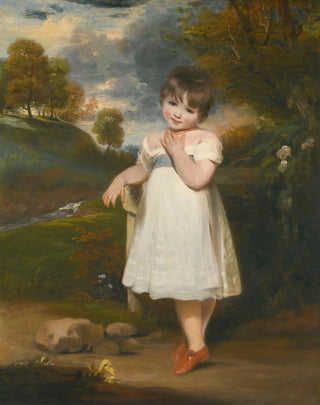Art print | Portrait of Emma Laura Whitbread, later Lady Eversley 1798-1857, when she was a child - John Hoppner


View from behind

Frame (optional)
Portrait of Emma Laura Whitbread, later Lady Eversley 1798-1857, as a child - John Hoppner – Engaging introduction
In the rich and diverse panorama of early 19th-century British art, John Hoppner's work stands out for its ability to capture innocence and youthful beauty. The "Portrait of Emma Laura Whitbread, later Lady Eversley, 1798-1857, as a child" is a compelling example of this mastery. This painting, which transcends a simple portrait to become a true ode to youth, evokes deep emotions and palpable nostalgia. Hoppner, as a renowned portraitist, manages to infuse his subjects with a life and personality reflected in every brushstroke, making this work a timeless testament to childhood.
Style and uniqueness of the work
Hoppner's style is characterized by an intimate and delicate approach, where light plays a crucial role. In the portrait of Emma Laura Whitbread, the softness of colors and the finesse of details demonstrate meticulous attention to the depiction of the child. The delicate features of her face, framed by luminous blonde hair, are highlighted by a harmonious background that seems almost ethereal. This stylistic choice creates a dreamlike atmosphere, where the figure of the child emerges gracefully. Emma's natural pose, her curious gaze, and her light smile convey a lively personality, thus capturing the spirit of childhood. Hoppner, by playing with textures and nuances, manages to give an almost tactile dimension to his work, inviting the viewer to immerse themselves in this universe imbued with tenderness.
The artist and his influence
John Hoppner, born in 1758, established himself as one of the most prominent portraitists of his time, rivaling artists such as Thomas Lawrence. His training at the painting school and his influence by earlier masters allowed him to develop a unique style, combining realism and romanticism. Hoppner was often commissioned by the British aristocracy, and his portraits became symbols of status and prestige. His ability to capture

Matte finish

View from behind

Frame (optional)
Portrait of Emma Laura Whitbread, later Lady Eversley 1798-1857, as a child - John Hoppner – Engaging introduction
In the rich and diverse panorama of early 19th-century British art, John Hoppner's work stands out for its ability to capture innocence and youthful beauty. The "Portrait of Emma Laura Whitbread, later Lady Eversley, 1798-1857, as a child" is a compelling example of this mastery. This painting, which transcends a simple portrait to become a true ode to youth, evokes deep emotions and palpable nostalgia. Hoppner, as a renowned portraitist, manages to infuse his subjects with a life and personality reflected in every brushstroke, making this work a timeless testament to childhood.
Style and uniqueness of the work
Hoppner's style is characterized by an intimate and delicate approach, where light plays a crucial role. In the portrait of Emma Laura Whitbread, the softness of colors and the finesse of details demonstrate meticulous attention to the depiction of the child. The delicate features of her face, framed by luminous blonde hair, are highlighted by a harmonious background that seems almost ethereal. This stylistic choice creates a dreamlike atmosphere, where the figure of the child emerges gracefully. Emma's natural pose, her curious gaze, and her light smile convey a lively personality, thus capturing the spirit of childhood. Hoppner, by playing with textures and nuances, manages to give an almost tactile dimension to his work, inviting the viewer to immerse themselves in this universe imbued with tenderness.
The artist and his influence
John Hoppner, born in 1758, established himself as one of the most prominent portraitists of his time, rivaling artists such as Thomas Lawrence. His training at the painting school and his influence by earlier masters allowed him to develop a unique style, combining realism and romanticism. Hoppner was often commissioned by the British aristocracy, and his portraits became symbols of status and prestige. His ability to capture






